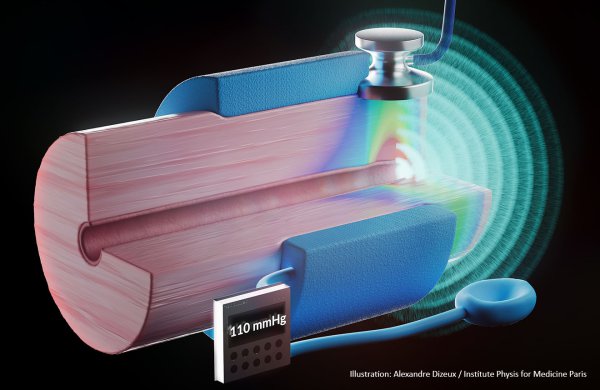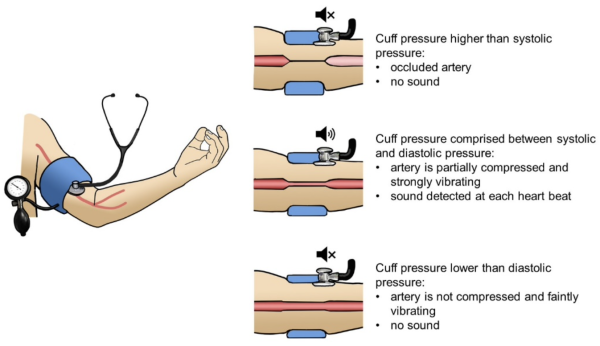
Invented over a century ago, it certainly is the most common clinical examination: each one of us already had its blood pressure measured using an inflatable cuff and a stethoscope. However, the fundamental principle of this measurement remained until now a mystery in the world of physics. Researchers from the Institute Physics for Medicine Paris (Inserm, ESPCI Paris-PSL, CNRS – France) have solved this enigma by studying in details the mechanical phenomena occurring in the arm when blood pressure is measured. The results are published on October 4th 2023, in frontpage of Science Advances.
Blood pressure measurement aims to evaluate the blood pressure in the arteries, and more precisely its maximum (systolic pressure) and minimum (diastolic pressure) value during the cardiac cycle. To do this, the doctor places an inflatable cuff on the patient’s arm, and a stethoscope at the end of the cuff on the elbow side. First, the cuff is inflated until it temporarily blocks blood circulation, like a tourniquet. Then, the doctor gradually deflates the cuff while listening through his stethoscope. When the pressure applied by the cuff becomes equal to the pressure of the blood in the brachial artery (which passes under the cuff), some blood manages to flow into the artery again and a very characteristic noise, a sort of clicking sound, is heard in the stethoscope. The doctor notes the value of the cuff pressure, e.g. 120 millimeters of mercury (denoted mmHg), which gives the systolic blood pressure. Gradual decompression of the cuff continues, and the characteristic sound is heard through the stethoscope at each heartbeat. Finally, when the cuff pressure becomes lower than the diastolic blood pressure, the noises stop in the stethoscope: the doctor notes again the pressure, e.g. 80mmHg. The doctor can then announce: “you have 12-8 blood pressure”; which means 120mmHg in systole, and 80mmHg in diastole.
The noises heard through the stethoscope are called "Korotkoff noises", named after their discoverer and Russian doctor, Nicolai Korotkoff, in 1905.
 Principle of a blood pressure measurement using an inflatable cuff.
Principle of a blood pressure measurement using an inflatable cuff.
Beneath its trivial appearance, this fundamental act of medicine hides an old mystery of physics and the human body: what is causing these famous Korotkoff noises, which are so important for measuring blood pressure? Blood flowing through the arteries doesn’t usually make a sound, so why does it start to sing after adding an inflatable cuff? Dozens of theories have been proposed in the past with no actual proof.
The team of Mickaël Tanter, research director at Inserm and director of the Institute Physics for Medicine Paris (France), managed to unravel the mystery of this phenomenon. Using ultrafast ultrasound imaging (a kind of high-performance ultrasound), researchers captured what was happening in the patient’s arm when blood pressure was taken, at thousands of images per second.
First, they discovered that, paradoxically, as the cuff inflates and presses on the brachial artery, the artery becomes softer. To picture this, let’s imagine a garden hose: when we open the tap, the hose becomes very stiff due to the pressurized water pushing on its walls. But if a bike rolls on the pipe, the pipe deforms easily: the pressure applied by the wheel counterbalances that of the water in the pipe. Locally, it is therefore as soft as if it was empty, and can change in shape. The same thing happens in our arm: the brachial artery is usually very stiff due to blood pressure, but the pressure of the cuff compensates for it. This results in a very soft artery under the cuff.
When the heart contracts and expels the blood from the ventricle towards the organs, the blood pressure increases suddenly and this increase propagates rapidly in the arteries, from the heart towards the edges of the body, this is the phenomenon of the pulse wave. The speed of this pulse wave is linked to the stiffness of the artery: the stiffer the artery, the faster the pulse wave propagates. When the wave reaches the softened portion of the artery under the cuff, it slows down considerably and greatly distends the soft walls of the artery, making them vibrate very strongly. This is a first key towards unraveling the mystery: the compression of the cuff softens the brachial artery and increases its vibrations under the effect of the pulse wave.
Then, the researchers showed that, throughout its propagation under the cuff, the pulse wave gradually transforms into a shock wave, just like an ocean wave would gradually break, due to the very unusual elastic properties of the compressed artery. Thus, the vibrations gradually pass from low frequencies corresponding to very low-tone sounds that are barely audible, to slightly higher frequencies, therefore more acute and more perceptible sounds. This is the second key of the mystery: the propagation of the pulse wave in the soft artery gradually shifts its vibrations towards audible frequencies.
Finally, the researchers were able to show that these vibrations of the artery were transmitted to the surrounding muscles in the form of a shear wave, similarly to an earthquake in which the arterial wall would be the epicenter. When this muscular earthquake reaches the surface of the arm and the stethoscope, it causes the latter to vibrate, which finally produces sound: the famous Korotkoff sounds!
The researchers compiled all these observations to finally write the theory which describes the generation and propagation of Korotkoff sounds. It is a mystery, unsolved for more than a hundred years, which is being elucidated by the combination of modern imaging techniques and wave mechanics equations. In addition to providing a fundamental physical explanation, this work could also allow greater reliability in blood pressure measurement.
Contacts
Jérôme Baranger Jerome.baranger@espci.fr, Mickael Tanter mickael.tanter@espci.fr
Institute Physics for Medicine Paris (Inserm, ESPCI PSL Paris, CNRS)
Parisanté Campus, 2-10 rue d’Oradour sur Glane, 75015 Paris, France
Full-text publication
J. Baranger, O. Villemain, G. Goudot, A. Dizeux, H. Le Blay, T. Mirault, E. Messas, M. Pernot, M. Tanter, Fundamental understanding of the Korotkoff sounds, Science Advances, 2023
https://www.science.org/doi/full/10.1126/sciadv.adi4252







